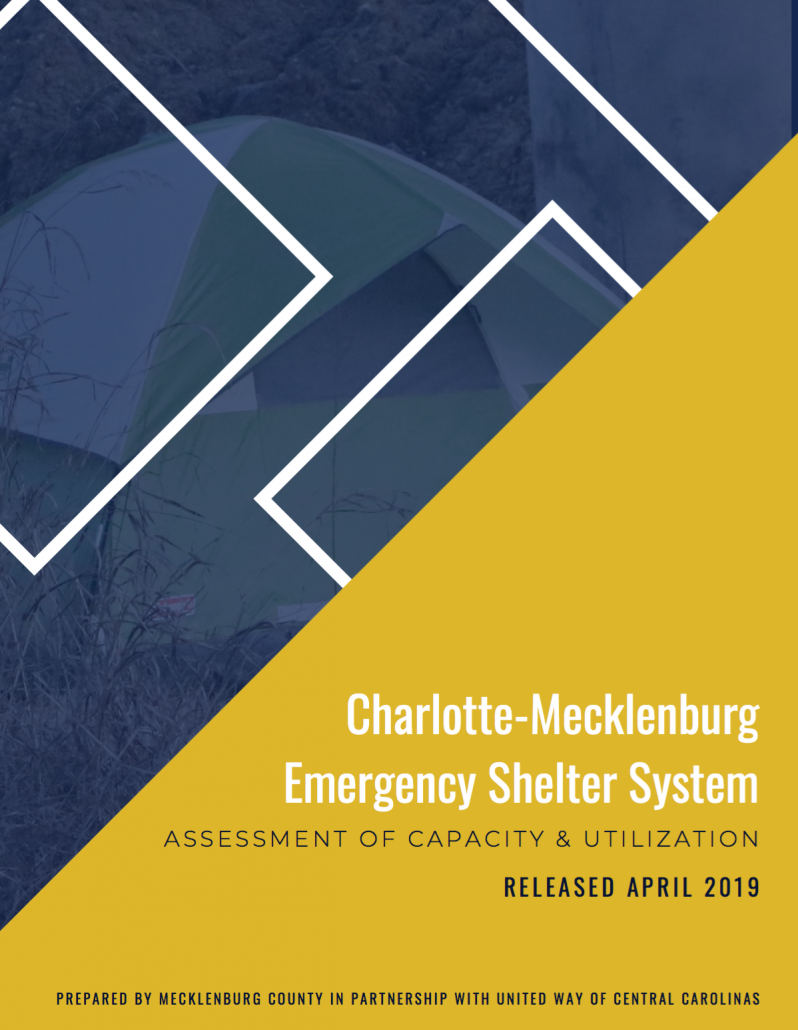Adelaide Belk & Kathryn Firmin-Sellers
United Way of Central Carolinas
This week, “The Charlotte-Mecklenburg Emergency Shelter System: Assessment of Capacity and Utilization” was released, providing the community with a comprehensive look at the overall emergency shelter system. The assessment was completed by Mecklenburg County Community Support Services in partnership with United Way of Central Carolinas.
This blog post will provide an overview of the assessment, its key points, the context behind it and what the assessment can mean for Charlotte-Mecklenburg.
ABOUT THE ASSESSMENT
As a convener and community partner, United Way of Central Carolinas works to bridge the public and private sectors and to improve the systems that serve children and families. Over the past 18 months, United Way facilitated a series of meetings with emergency shelter providers to seek opportunities for improved system efficiency and effectiveness. The providers identified areas for improved collaboration and coordination across shelters and, where possible, implemented changes. However, the providers also wanted to be able to maximize their effectiveness as a system. With no system-wide evaluation materials readily available, the providers and United Way engaged Mecklenburg County to design and complete the assessment.
The assessment details the changes that can be made at both the provider and the system level to enhance capacity and more efficiently move individuals and families from homelessness to housing.
KEY POINTS
Emergency shelters are stronger when functioning as a system than as individual providers. The emergency shelter programs that make up the overall system have different eligibility requirements, target populations and operating procedures. While there are differences, the system can identify opportunities for collaboration. The assessment imposes a comprehensive framework to evaluate the full system and offers recommendations. Emergency shelter providers have taken initial steps, including pooling resources to purchase bed bug equipment that could be shared among shelters.
Emergency shelters play a critical role within the context of the larger housing continuum. Emergency shelters are uniquely positioned as a system to be a strong advocate around affordable housing. In addition to leadership that can effect change, shelter services and resources serve as a community asset, strengthening the connections from homelessness to housing. Emergency shelter providers can leverage their collective strength and optimize the shelter system while simultaneously addressing housing capacity.
SO, WHAT
United Way will continue to facilitate conversations with emergency shelter providers and partner agencies to respond to the assessment, as well as with private and public funders to understand the implications for strategic investment.
Here are two of our major takeaways and what we plan to do next:
- Describe the impact of funding to uplift characteristics of an effective emergency shelter system. United Way plans to help others connect the dots to address system-level change, highlighting recommendations in the report, such as common language, diversion funding and additional research. United Way plans to address the need for increased adaptability and flexibility by the ways in which it deploys its own funding.
- Advocate for system-levels policies and actions that improve systems. United Way plans to integrate the recommendations for emergency shelter in conversations across the housing continuum. The emergency shelter system is both impacted by and has impacts on other systems in the community. It is important that connections continue to be drawn between and across all systems.
Adelaide Belk is the AVP of Community Impact and Special Initiatives and Kathryn Firmin-Sellers is the Chief Impact Officer.


